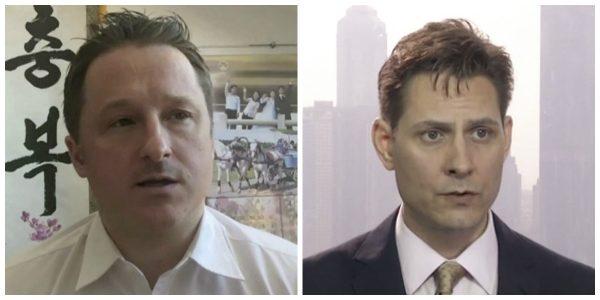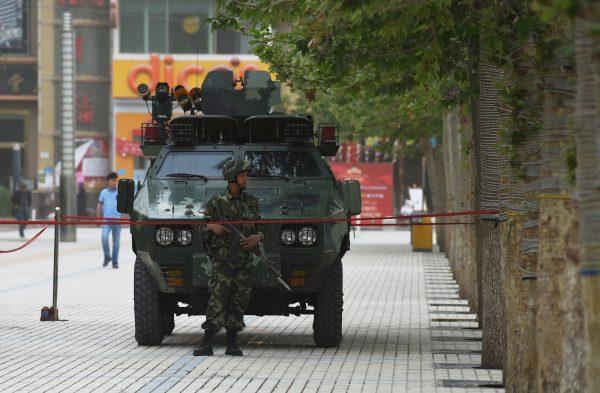TORONTO—Almost three years before Canadians Michael Kovrig and Michael Spavor were detained by Chinese authorities, Swedish activist Peter Dahlin suffered a similar ordeal in China.
The co-founder of China Action, an NGO that supported human rights lawyers in China, Dahlin was detained in Beijing in early January 2016, kept in captivity for 23 days, and subjected to intense interrogation.
Based on his own experience, Dahlin says Kovrig—who, like him, was captured in Beijing—is likely being held in the same facility as he was: a four-storey, two-winged secret prison in the southern part of the city. Spavor, who is based in Northeast China, is probably being held in a different facility.
Both men were detained on what Beijing claims are charges of endangering national security, shortly after Canada arrested Huawei CFO Meng Wanzhou on an extradition request from the United States.
“[Kovrig] might even have the same two lead interrogators as I did,” as it is not so common to have foreigners kept in these facilities, Dahlin told The Epoch Times.

He guesses Kovrig’s days in custody are spent being grilled for hours by a “good cop-bad cop” interrogation duo across from his suicide-padded cell, with the sessions often going late into the night to ensure he “doesn’t get proper sleep.”
When not in interrogation he will be in his cell, accompanied by two guards who keep a record of even his slightest move, such as turning over in bed, Dahlin adds.
“The heavy curtains will likely be pulled over the window, so he will have no idea of time really, and lights are always on in his cell. The guards will watch closely, whether he is allowed to shower, which is rare, or use the bathroom. It’s uncomfortable, but you get used to it rather quickly actually.”
Kovrig and Spavor are allowed only limited access to Canadian consular officials and have been denied legal representation.
“There have also been reports that the lights are kept on in their cells day and night, which is a form of torture in terms of sleep deprivation,” said Farida Deif, Canada director at Human Rights Watch (HRW).
Dahlin says in his case, besides being denied sleep, he was also threatened with a life sentence.
However, as bad as this mental torture may be, Dahlin says, the two Canadians have it much better than most held in these facilities who are not foreigners.
According to Patrick Poon, the Hong Kong-based China researcher at Amnesty International, people detained in China are often exposed to various kinds of torture and mistreatment.

Poon said Amnesty has received reports of detainees suffering beatings that go on for hours, or being tied tightly in a painful position on a “tiger bench” for long periods of time.
“Forcing a person into such a position while being tied for such a long time can make the person’s limbs suffer various kinds of injuries,” he said.
Persecution and Torture
According to HRW’s Deif, the Chinese regime uses any means at its disposal “to silence anyone who is outside of being a blind supporter of the Chinese Communist Party.”Joel Chipkar, a Toronto-based spokesperson for the Falun Dafa Information Centre, said according to reports they receive, Falun Dafa adherents detained in China are tortured in a variety of ways, including being force-fed psychotropic drugs, sexual abuse including repeated rape, being tied in painful positions for days, being starved, being stripped naked and put outside in freezing cold for hours, and being shocked with electric batons, to name a few. In some cases, these prisoners of conscience even die due to torture, he said.
Falun Dafa, also known as Falun Gong, is a meditation exercise based on the principles of truthfulness, compassion, and tolerance. After it was made public in 1992, between 70 million to 100 million people took up the practice, according to Chinese government figures. However, this large following became a source of concern for then-Chinese Communist Party (CCP) leader Jiang Zemin, who launched a large-scale persecution against the practice in 1999.
Chipkar said Falun Dafa adherents are persecuted because they want to protect their freedom to believe in their principles and practice their faith. He said since the CCP is atheist, they want to force adherents to “renounce their faith.”
“The persecution of Falun Gong is so crazy that all a detained practitioner has to do is sign a piece of paper saying that he’s not going to practice his faith any longer and he’s allowed to go home. It’s completely bizarre,” he said.
Louisa Greve, a Washington-based director of external affairs for the Uyghur Human Rights Project, lists a number of abusive methods used against Uyghurs in custody, including beatings; death under torture has occurred in many cases.

Greve notes it’s important to recognize the psychological torture endured by the Uyghur Muslim minority group. “It is a form of torture and ’spiritual harm' to force Muslims to eat pork, for example,” she said.
“State kidnapping of children and keeping them forever is also a form of torture for the children and the parents and grandparents,” she added.
A 2017 U.S. Department of State report says Chinese law prohibits physical abuse and mistreatment of detainees. However, the report notes, numerous people have reported being tortured while in custody in China.
“Members of the minority Uighur ethnic group reported systematic torture and other degrading treatment by law enforcement officers and the penal system,” the report says. “Practitioners of the banned Falun Gong spiritual movement reported systematic torture more often than other groups.”
A 2015 Amnesty International report titled “No End in Sight: Torture and Forced Confessions in China” notes that use of torture in China remains rampant.
“Torture and other cruel, inhuman or degrading treatment or punishment (other ill-treatment) have long been prevalent in all situations where authorities deprive individuals of their liberty in China,” the report said.
- Over 100 Torture Methods Used in China’s Prison System
- Tortured in China: Two Canadians Who Lived to Tell the Tale
- 4 Cases of Sexual Torture of Falun Dafa Adherents Documented by Gao Zhisheng
- Sexual Torture of Detained Falun Dafa Adherents Rampant: Rights Lawyer
- Sexual Torture in Chinese Prisons: ‘No Limits to the Perversion’
- An Unprecedented Crime: State-Directed Mass Killing of Prisoners of Conscience in China for Their Organs
- Forced Organ Harvesting: Overseas Patients Flocking to China for Transplants
- Psychological Torture: Worst Scars Are in the Mind
- Psychiatric Torture and the Unspeakable Suffering It Causes
- Healing Betrayed: The Perversion of Psychiatry in China





